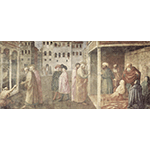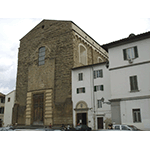Church of Santa Maria del Carmine
This church, begun in 1268, was completed during the second half of the 15th century (1476). It was radically transformed during the 16th and 17th centuries, and in 1771 was largely destroyed by a fire and afterwards reconstructed in its present form by 1775. The terrible blaze spared only the exterior part of the original structure, the sacresty, the Corsini chapel – designed in the Baroque period by Pier Francesco Silvani – and the Brancacci chapel. The fresco decoration of the Brancacci chapel, done by Masolino and Masaccio, was undertaken probably in 1424 but was interrupted around 1427-1428 when Masaccio left Florence to go to Rome. The work, left unfinished, was completed by Filippino Lippi after 1480. The cycle, one of the most important in Italian painting, narrates the story of human salvation made possible by the sacrifice of Christ and realized by the church through Saint Peter. In his frescoes Masaccio gave a marvelous rendering of perspective, which he studied in that period along with Brunelleschi and Donatello, and which was afterwards theorized and put into practice by, among others, Leon Battista Alberti and Piero della Francesca.
During the same period the church was also a center for the staging of episodes from the New Testament, with the employment of so-called "engines", which were complex mechanisms and lighting systems designed to enliven these sacred dramatizations. We find mention of the representation at Santa Maria del Carmine of the Ascension and of other similar plays in the 15th-century descriptions of the Russian prelate Abraham of Soudzal and again in the 16th century in the works of Vasari (Vita del Cecca and Vita di Filippo Brunelleschi) and Niccolò Frabbrini. These sources provide rare testimony about the technical means used in theatrical productions of that era.
It should be noted that from the time of Galileo’s sojourn in Padua, the family home was located within the parish of Santa Maria del Carmine. His sister Virginia Galilei probably resided there with her husband Benedetto Landucci and their mother Giulia Ammannati, who was buried in that very church in 1620.
****************************
Texts by Nicoletta Baldini
English translation by Edward Tosques
Last update 16/apr/2009





